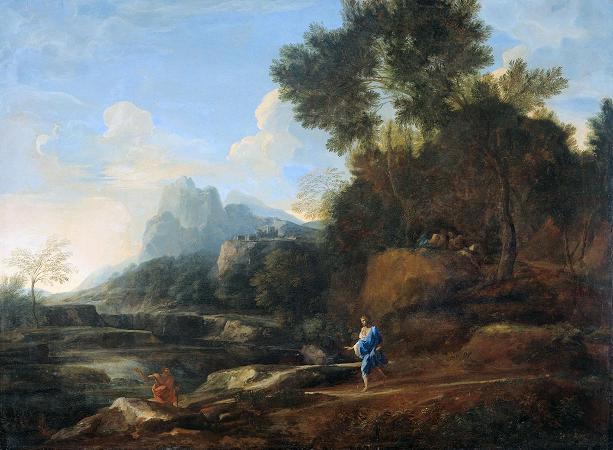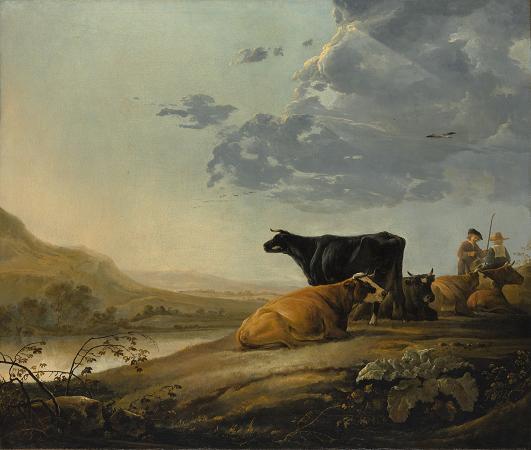Claude Lorrain (c1600 - 1682). Claude Lorrain was a French painter, draughtsman and etcher of the Baroque era. He spent most of his life in Italy, and is one of the earliest important artists, apart from his contemporaries in Dutch Golden Age painting, to concentrate on landscape painting. His landscapes are usually turned into the more prestigious genre of history paintings by the addition of a few small figures, typically representing a scene from the Bible or classical mythology. By the end of the 1630s he was established as the leading landscapist in Italy, and enjoyed large fees for his work. These gradually became larger, but with fewer figures, more carefully painted, and produced at a lower rate. He was not generally an innovator in landscape painting, except in introducing the Sun into many paintings, which had been rare before. He is now thought of as a French painter, but was born in the independent Duchy of Lorraine, and almost all his painting was done in Italy; before the late 19th century he was regarded as a painter of the Roman School. His patrons were also mostly Italian, but after his death he became very popular with English collectors, and the UK retains a high proportion of his works. He was a prolific creator of drawings in pen and very often monochrome watercolour wash, usually brown but sometimes grey. Chalk is sometimes used for under-drawing, and white highlighting in various media may be employed, much less often other colours such as pink. These fall into three fairly distinct groups. Firstly there are large numbers of sketches, mostly of landscapes, and apparently very often done at the scene; these have been greatly admired, and influenced other artists. Then there are studies for paintings, of various degrees of finish, many clearly done before or during the process of painting, but others perhaps after that was complete. This was certainly the case for the last group, the 195 drawings recording finished paintings collected in his Liber Veritatis. He produced over 40 etchings, often simplified versions of paintings, mainly before 1642. These served various purposes for him, but are now regarded as much less important than his drawings. He painted frescoes in his early career, which played an important part in making his reputation, but are now nearly all lost. The earliest biographies of Claude are in Joachim von Sandrart's Teutsche Academie and Filippo Baldinucci's Notizie de' professori del disegno da Cimabue in qua. Both Sandrart and Baldinucci knew the painter personally, but at periods some 50 years apart, respectively at the start of his career and shortly before his death. Sandrart knew him well and lived with him for a while, while Baldinucci was probably not intimate with him, and derived much of his information from Claude's nephew, who lived with the artist. Claude's tombstone gives 1600 as his year of birth, but contemporary sources indicate a later date, circa 1604 or 1605. He was born in the small village of Chamagne, Vosges, then part of the Duchy of Lorraine. He was the third of five sons of Jean Gellee and Anne Padose. According to Baldinucci, Claude's parents both died when he was twelve years old, and he then lived at Freiburg with an elder brother. Jean was an artist in inlay and taught Claude the rudiments of drawing. Claude then travelled to Italy, first working for Goffredo Wals in Naples, then joining the workshop of Agostino Tassi in Rome. Sandrart's account of Claude's early years, however, is quite different, and modern scholars generally prefer this, or attempt to combine the two. According to Sandrart, Claude did not do well at the village school and was apprenticed to a pastry baker. With a company of fellow cooks and bakers, Claude travelled to Rome and was eventually employed as servant and cook by Tassi, who at some point converted him into an apprentice and taught him drawing and painting. Both Wals and Tassi were landscapists, the former very obscure and producing small works, while Tassi had a large workshop specializing in fresco schemes in palaces. While the details of Claude's pre-1620s life remain unclear, most modern scholars agree that he was apprenticed to Wals around 1620-1622, and to Tassi from circa 1622/23 to 1625. Finally, Baldinucci reports that in 1625 Claude undertook a voyage back to Lorraine to train with Claude Deruet, working on the backgrounds of a lost fresco scheme, but left his studio comparatively soon, in 1626 or 1627. He returned to Rome and settled in a house in the Via Margutta, near the Spanish Steps and Trinita dei Monti, remaining in that neighbourhood for the rest of his life.
more...














